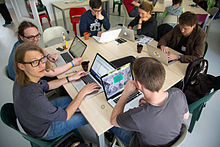Learning patterns/Coding da Vinci - the culture hackathon/pt
What problem does this solve?

It is not always easy to obtain open licenses for content from cultural institutions (GLAM) to be re-used in Wikimedia projects. Many GLAM institutions consider it sufficient to display their digital content on their websites. They often lack the motivation to make it available for private or commercial re-use by obtaining open licenses. They may also not know about the kinds of applications that individuals outside of the institutions could create with GLAM content if they had access to it.
Only a few GLAM institutions employ their own software developers to create their own applications and other interactive websites. There is usually no contact with existing communities of coders and hackers, making it difficult to set up joint projects. Similarly, coders and developers interested in GLAM content rarely have contacts with GLAM institutions that would give them access to digital cultural assets to use as raw material for their application ideas. That’s where the Coding da Vinci collaborative project comes in: a “culture hackathon” run by the Deutsche Digitale Bibliothek, the Open Knowledge Foundation Deutschland, digiS and Wikimedia Deutschland.
Qual é a solução?

Coding da Vinci is a collaborative project that makes hundreds of thousands of different kinds of media files accessible as open content as defined by the Wikimedia projects and, by providing concrete application ideas, is a high-profile and effective way of encouraging GLAM institutions to release further open content to the knowledge commons under open license. The Coding da Vinci format is slightly different from that of other hackathons:
- Coding da Vinci focuses on cultural data.
- All available data are under an open license.
- The source code of all applications is under an open license.
- GLAM institutions work together with developers and designers.
- Coding da Vinci has a 48-hour kick-off event.
- Coding da Vinci offers a ten-week “hack sprint” to develop the kick-off ideas into products that are as market-ready as possible.
- An expert jury selects five prize winners in five categories from the projects presented at the award ceremony. (The public also nominated a prize winner in 2015.)
- The hackathon’s organization team brings together the coder and GLAM communities.
- Each project uses at least one dataset provided for the hackathon.
- The Coding da Vinci founding team consists of the Deutsche Digitale Bibliothek, the Service Center for Digitization, the Open Knowledge Foundation Deutschland and Wikimedia Deutschland.
Fase de preparação:

- Contacting GLAM institutions to ask them to release datasets for Coding da Vinci under open licenses and present them at the kick-off.
- Contacting developers, coders, designers and other interested parties via universities and community associations. (We recommend offering participants grants for travel and accommodation.)
- Preparação do evento
- Setting up the hackathon’s website, where participants can access the datasets, application projects and information about the competition and event, and register themselves.
Primeira meta:
Labor-intensive kick-off event with all participants featuring:
- Presentation of the datasets by GLAM institutions
- Formation of project teams based on existing project ideasWorkshop proposals for coders
- Meet-up for GLAM institutions and hackers
Fase de implementação:
- Preparando um salpicadero para os projectos
- Apoiando, motivando e aconselhando as equipas
- Tentando prêmios
- Preparação do evento
- Pulsar trabalho
Segunda meta:
A public award ceremony where the projects are presented to the jury and the public. Representatives from the media, politics and other GLAM institutions can be invited to the event to popularize the range and variety of opportunities for re-using freely licensed cultural assets.
Dokumentation und Evaluationsphase

Revisão:
Wikimedia Deutschland has organized Coding da Vinci twice on a large scale with the aforementioned partner institutions. Around 150 developers took part in each of the events. A total of more than 40 GLAM institutions collaborated on Coding da Vinci. Besides the large amounts of metadata, a total of more than 600,000 media files were made available under open licenses – some specifically for Coding da Vinci – including paintings, printed graphics, photographs, films, animal sounds, plants, insect scans, and a huge amount of text material, as well as historic patent drawings, photographic images and piano rolls for player pianos. These materials have yet to be uploaded in bulk to Wikimedia Commons, so the Coding da Vinci website is currently still serving as a data portal. A total of 39 projects have been created in two years, ranging from augmented reality apps for iPads to an alarm clock app with a birdsong quiz. The websites, apps, games, twitter applications and elaborate hardware installations created clearly demonstrate the creative potential of digital cultural assets in the hands of hackers.
Padrões relacionados
- Towards a Successful GLAM Partnership!
- ©©-Change your mind - a fun workshop for open licenses
- GLAM on Tour - connecting Wikipedians and cultural institutions on the local level
- Wikipedian KulTour – the little sister of GLAM on Tour
- Wikiverse World Café - getting to know Wikimedia projects and volunteers
- Falhando numa campanha de financiamento da multidão
Ligações externas
- Short film on Coding da Vinci (in German)
- The Coding da Vinci website, including the documentation (in German) on 2014 and 2015 editions of the project
- Pronta de tarefa of data sets to upload to Wikimedia Commons
- Imagens e multimédia coverage of the events on Wikimedia Commons
- Blogpost in English on Coding da Vinci 2014
- Blogpost in English zu Coding da Vinci 2015

